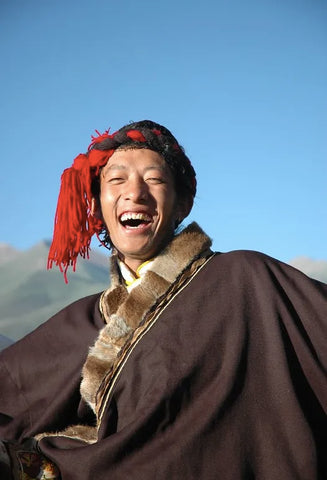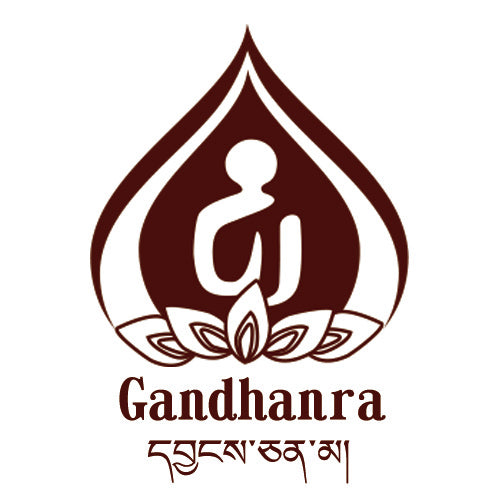
"The high snow mountain is a great place for us to dance and sing..."
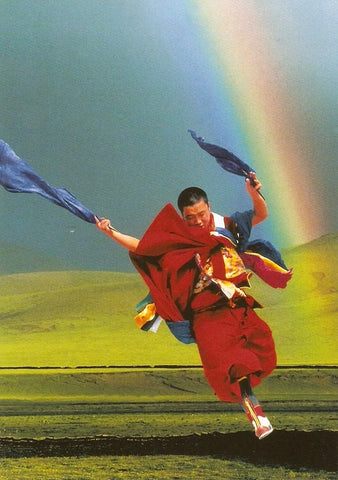
"When a hundred birds sing together, spring returns to the earth.
The happiest moment is when we sing and dance."
- Tibetan folk song "The Song of Happiness"


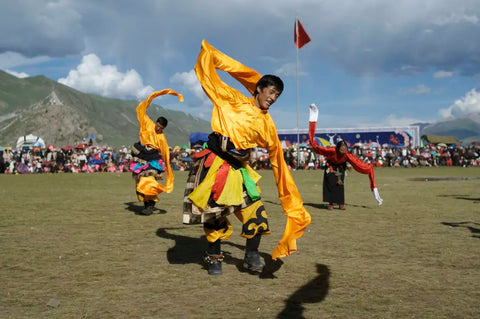

Dancers on the Plateau
Photo by Zachary Freedman
Dance of Life
Tibet is not only an ocean of wisdom, but also an ocean of song and dance. Tibetan proverbs describe the inherent strong artistic genes of the highland people, saying, "Those who can speak can sing, and those who can walk can dance."
In terms of style, some Tibetan dances are like eagles soaring in the blue sky, showing boldness and magnificence; some have smaller movements, with hand gestures, light steps, and rotations following a certain rhythm, giving a feeling of elegance and relaxation; some dances are performed in elaborate and unique costumes, with exaggerated masks, exuding a sense of divinity and mystery, inspiring awe; while some dances spontaneously appear in everyday life scenes such as harvests, gatherings, archery, feasting, construction, and travels, showing a casual, free, and joyful spirit.
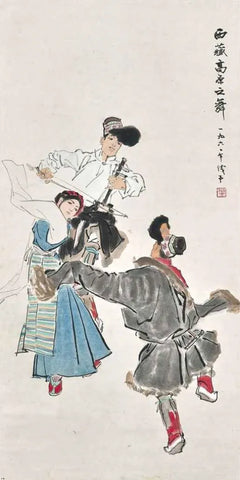
Dance of the Tibetan Plateau
Painted by the renowned artist Mr. Ye Qianyu in the 1960s-1980s
Tibetan dances come in various forms and styles, with each one reflecting the people's admiration and prayer for natural scenery and a better life, as well as expressing the subtle emotions and longing during courtship, celebrating harvests, purifying impurities, or expressing faith. The spiritual meanings carried by these dances vary depending on the different needs they fulfill.
However, regardless of the dance form, the spiritual outlook and way of life of the people on the plateau are vividly reflected through beautiful dance movements.

Dance of the Tibetan Plateau
Painted by the renowned artist Mr. Ye Qianyu in the 1960s-1980s
Lasazidui, Jiuhezuowu, and Batangxianzi are all outstanding representatives of Tibetan traditional dance arts that have gained a great reputation. These dances have been included in the national intangible cultural heritage list due to their long history, unparalleled artistic charm, and profound cultural significance they carry. This not only reflects the irreplaceable humanistic value of these dances being recognized and respected, but also highlights the urgent need to protect and inherit traditional arts.

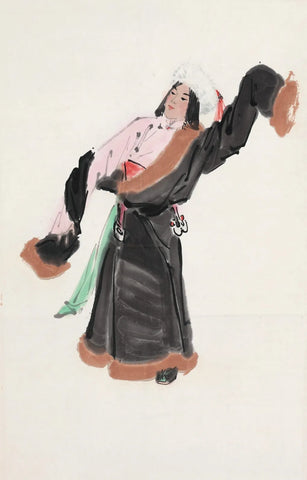
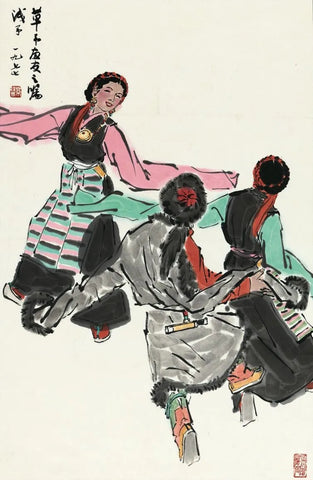
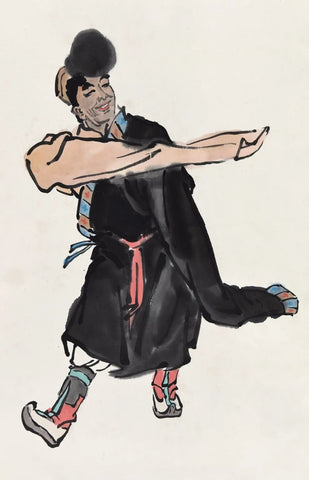
Dance of the Tibetan Plateau
Painted by the renowned artist Mr. Ye Qianyu in the 1960s-1980s
Language that transcends borders.
Based on performance style, performance program, artistic features and spiritual meanings, Tibetan dance can be roughly divided into four types: folk, religious, opera, and court dance. Each type of dance can be further subdivided based on the subtle differences in posture and steps, creating many branches. Folk dance is different from religious dance, solo dance is different from group dance, male dance is different from female dance, and the Tibetan ethnic group is widely distributed, leading to different regional styles.

Qiangmu dance performance at festival ceremonies
Image: ThinkStock Photos
If one wants to clarify all the existing dance types in Tibetan areas, and specifically summarize their styles and forms of expression, tracing their historical origins may not be an easy task. However, this does not affect our ability to appreciate the infinite charm of Tibetan dances.
As a vibrant form of artistic expression, dance itself is a language that transcends borders and civilizations. Accompanied by melodious drum beats, string music, and singing, the graceful dance movements connect the visual and spiritual senses of every audience member with the dancers. The cultural and cognitive barriers are eliminated, and the shared beautiful emotions brought by art make everyone feel connected and united.

Beautiful dancers at a festival ceremony in Litang
Photograph by Alex Saurel
Due to the limited space, in this article we will share and show the representative characteristics of various types of dances, including their artistic styles and spiritual connotations.
Dancing gracefully with strings

Photography by David Ducoin.
Xianzi dance and Guozhuang dance are typical folk dances in Tibetan areas. Xianzi is a colloquial term for "harmony (meaning song and dance)", while Guozhuang is a term for "dance", with "Guozhuang" being the colloquial name. "Harmony" and "dance" in Tibetan both refer to song and dance.
Xianzi dance is often seen as lively and enthusiastic in its dance style. It is a folk collective dance for self-entertainment, and has a long history. According to research, Xianzi dance can be traced back to the Tang Dynasty. In Tibetan traditional beliefs, Xianzi dance can bring long-lasting peace, happiness, and auspiciousness to people.
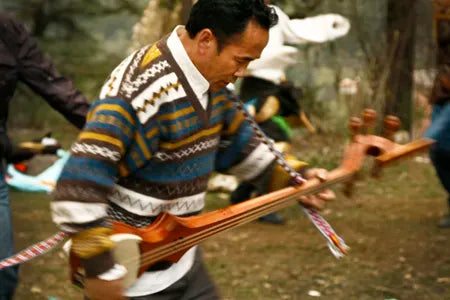

Sing and dance
Photography: Julia Hue
Xianzi dance is mainly popular in regions such as Batang and Ganzi in Sichuan, and Mangkang and Chamdo in Tibet, with Batang being the most famous for Xianzi dance. Nowadays, when people mention Xianzi dance, they usually habitually refer to it as "Batang Xianzi".
The performance of Xianzi dance is usually accompanied by melodious and rhythmic string music and lively and cheerful singing. People link arms and shoulders in a circle, singing and dancing together. Whether it's the singing, the steps, or other agile and subtle body movements, they all reflect a certain degree of skill, making it highly artistic and expressive. If you watch a Xianzi dance performance live, the emotions of the audience can be quickly stirred and immersed in such a beautiful and enjoyable atmosphere.
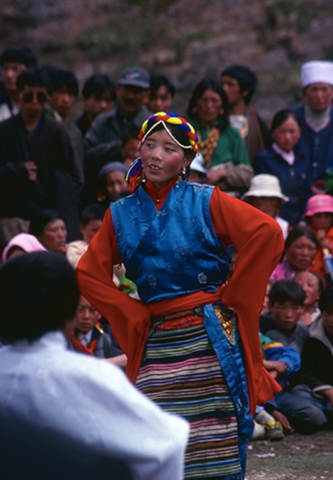
The pot dances.
One of the most well-known Tibetan dances that did not originate from the Tibetan plateau is perhaps the Guozhuang dance, which is also a vibrant part of Tibetan culture. The Guozhuang dance is the most popular and beloved dance form in Tibet, and is often performed by people in their leisure time.
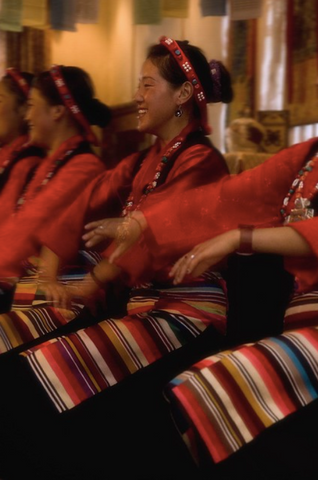
Gathering Dance
Photography by FishTan
The dance style of Guozhuang is different between regions in Tibetan areas, such as between agricultural areas and pastoral areas, with differences in hand gestures and body movements. However, despite the diverse forms, there is a unified spiritual core - that this dance art is a way for the wise people of the plateau to express their passion for life, a praise for life that emerges naturally from the heart, and is ultimately expressed beautifully and freely through agile and creative body movements.
Whether it is Guozhuang or Xianzi, their unique footsteps, body movements, and hand gestures must be closely coordinated with the rhythm of the music, dancing and singing in tune, presenting a clear sense of rhythm and beat. Therefore, it seems that dancers must master high-level skills to perform perfectly.
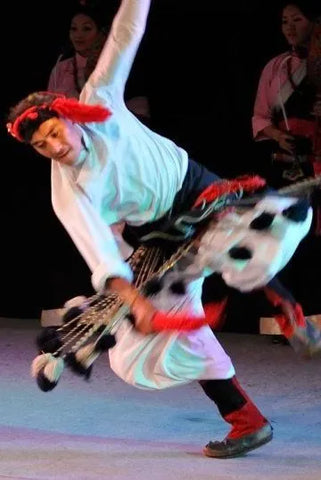
Dance of Prayer to the Gods
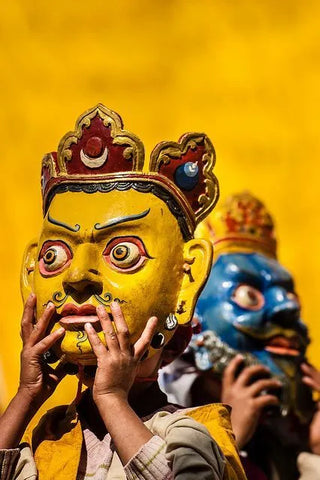
Photograph by David Ducoin
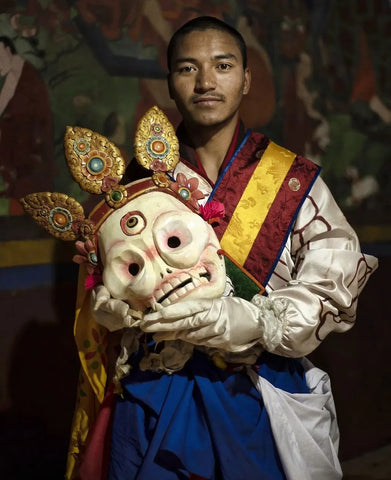
Image: magbrinik
Religious dances are usually performed by monks or priests in temples. During the performance, dancers wear colorful and unique costumes designed for dancing, as well as various props and different character masks. These costumes and masks are very heavy due to their intricate craftsmanship, but even so, the performing monks strive to balance beauty and precision in their movements. Therefore, only well-trained and physically fit monks are able to perform this sacred and important work perfectly.
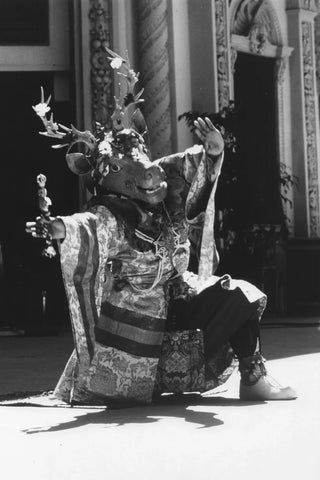
Photography: Don Farber
The Cham Dance, a representative religious dance, is a special form of dance in Tibetan Buddhism and an important religious ritual. In the Cham Dance, various animals and fierce and angry characters are often seen.
According to Tibetan cultural traditions, this dance can be seen as a wonderful metaphor for the battle between positive and negative energies, embodying important Buddhist cultural principles. By watching such a large-scale dance, people can directly and strongly feel the destruction of evil by justice. Appreciating a Cham Dance not only relaxes the mind, but also brings wisdom and blessings from the divine.

Qiang Mu dance performer 1957
Photography: Pietro Francesco Mele
Pietro Francesco Mele, the photographer who accompanied Tucci on academic exploration in Tibet last century, described his strong impression of the first time he witnessed the Cham dance in his Tibetan photo album published in 1957: "The monks dressed in ancient and precious robes, wearing strange masks, performing this sacred dance in the monastery during festivals. Most of the frightening figures are actually not demons, but represent a force of goodness and justice. They dress up in this peculiar way in order to ward off evil."
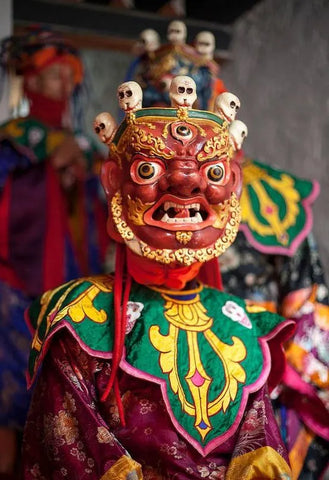
Qiang Mu dance performer
Photography: ira block
In a performance of Qiangmu dance, regardless of the strange costumes, exaggerated movements, fierce masks, or stylistic headgear, accompanied by the unfolding of drum music, it is full of layers of metaphors and symbolic meanings, making the whole performance full of dramatic tension. In the narrative scenes that conform to a specific ritual, this dance, full of strong ritualistic qualities, effectively conveys the abstract and subtle philosophical connotations of Buddhism to the onlookers.



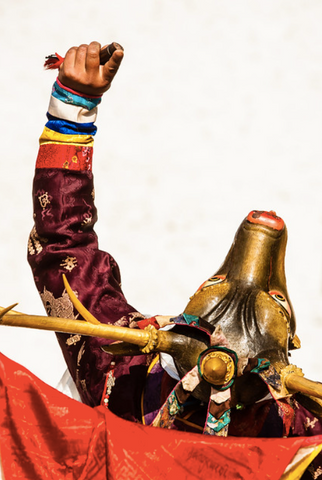
Qiang Mu Dance Performance
Photography: David Ducoin
As a dance performance art, Qangmu dance also serves as a moral guide. In Tibetan tradition, it is generally believed that this dance can bring blessings and wisdom to those who appreciate and understand it.

A group of young monks are watching a Qiangmu dance.
Photographer: Pietro Francesco Mele
Agilam
Opera dance is a type of dance that frequently appears in the performance of Tibetan opera. The history of Tibetan opera can be traced back to the 8th century, as it gradually evolved from religious and cultural practices with the development of social production and life, forming a unique and charming art form. Tibetan opera is also known as the living fossil of Tibetan culture.
The performance of Tibetan opera generally follows a three-part structure. It includes religious rituals and song and dance in the prelude, storytelling through song and dance in the middle part, and a closing section featuring blessing ceremonies.

A Tibetan opera actor wearing a hunter mask, playing the role of the narrator in the play "1922".
Photograph by Charles John Morris.
As a comprehensive art form, a traditional Chinese opera incorporates various art forms such as dance, recitation, instrumental music, and singing. Among them, dance forms typically include animal mimicry dances, dances depicting everyday life scenes, special rituals and blessing dances, and a series of stylized movements for specific characters in the plot, such as princes, princesses, fairies, wizards, and animals. The dance in traditional Chinese opera is rarely closely linked to the plot, but rather serves to create a stage atmosphere. Its essence still lies in reflecting the external expression of the human spiritual world.
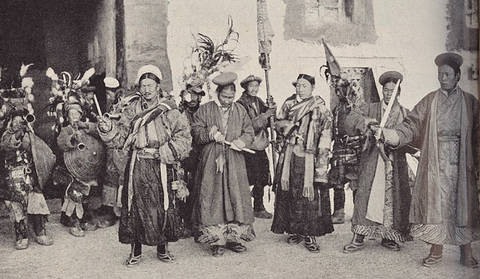
A Tibetan Dance Troupe 1936
Photography: Spencer Chapman
Citizen Art
In the long history and cultural traditions of Tibet, Nangma has always been a paradigm of dance and music art active in the aristocratic and bourgeois classes. "Nangma" means melody. It is generally believed that Nangma evolved from Duixie. "Dui" refers to some high-altitude areas in Tibet, and "xie" is a type of dance performed in these high-altitude areas.

Heap satire art
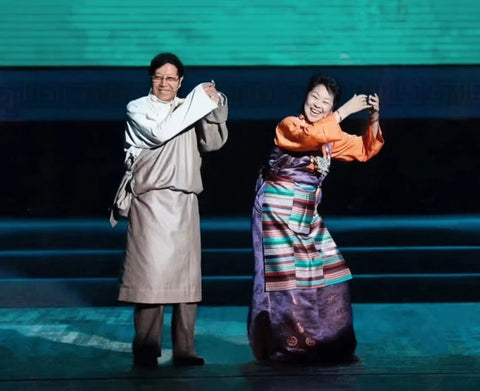
The combination of traditional instruments such as bamboo flute, zha nian, yangqin, genga, and jinghu, allows Nangma to present a more magnificent and artistic expression of beauty and grace.
Aesthetic values and spiritual truths
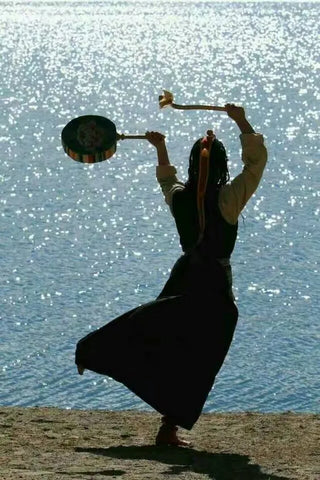
Image: Pinterest
The Tibetan people are widely distributed, with differing geographical environments and lifestyles. Through the historical exchange and integration with neighboring cultures, various factors have contributed to the diverse forms and styles of Tibetan dance art that we see today. Regardless of the type of dance, its core is to convey complex and subtle thoughts and emotions from deep within through a myriad of body language.
Not only dance, but all forms of art are essentially a sensory way for human beings to engage in spiritual practices, reflecting the real connection between spiritual pursuits and worldly life. In the belief system of the snowy land, these art forms, including dance, reflect the close and inseparable connection between people and nature, between humanity and the universe.
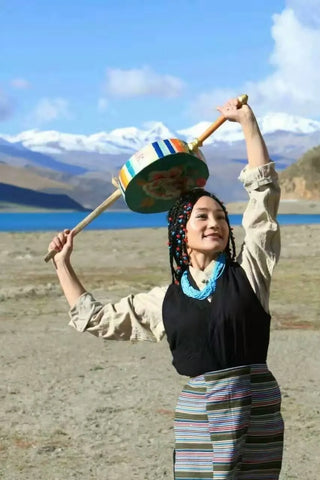
Image: Pinterest
On the plateau, people dance and sing under the sky and above the earth, creating an indescribably moving scenery. The pursuit of truth, goodness, and beauty has elevated dance beyond mere technical skill. It seems that only in the pure land of the highlands can such dance movements be presented with such a stirring vitality, releasing the beauty and soul that belong to it.
Just like a beautiful thangka, Tibetan dance is also a gene of Tibetan culture, carrying the memory of the ancient civilization of the plateau. As Tibetan dance crosses thousands of years of time and space, it still brings extraordinary aesthetic pleasure and inner inspiration to people. Meanwhile, the profound spiritual essence embedded within it silently impacts the hearts of the audience.
